The Life and Times of T.S. Elliot
Explore T.S. Elliot’s remarkable journey from St. Louis to literary greatness. Discover his influential modernist poetry, major works like The Waste Land, and lasting cultural impact in this comprehensive guide.

The Life and Times of T.S. Elliot
The Life and Times of T.S. Elliot: Thomas Stearns Eliot stands as one of the most influential literary figures of the 20th century, whose revolutionary approach to poetry transformed the landscape of modern literature. Born in St. Louis but spending most of his adult life in England, Eliot’s journey from a privileged American upbringing to becoming a defining voice of modernist poetry reflects the cultural and intellectual transformations of his era.
This comprehensive exploration delves into Eliot’s remarkable life, his groundbreaking literary contributions, and the lasting impact of his work on literature and culture. More Biography
T.S. Elliot Biographical Overview: The Making of a Literary Giant
The Life and Times of T.S. Elliot: Early Life and Education
Thomas Stearns Eliot was born on September 26, 1888, in St. Louis, Missouri, into a prominent Boston Brahmin family. The youngest of seven children, Eliot grew up in a household that valued intellectual pursuits and religious devotion. His mother, Charlotte Champe Stearns, was a teacher and poet, while his father, Henry Ware Eliot, was a successful businessman. This combination of intellectual and practical influences would later shape Eliot’s worldview.
Despite moving away from St. Louis at the age of sixteen, Eliot later wrote that “Missouri and the Mississippi have made a deeper impression on me than any other part of the world.” His childhood was marked by physical limitations due to a congenital double inguinal hernia, which prevented him from participating in many physical activities. This isolation fostered his love for literature as he found solace in books.
Eliot’s formal education began at Smith Academy in St. Louis, where he studied from 1898 to 1905. He then attended Milton Academy in Massachusetts for a preparatory year before enrolling at Harvard University in 1906. At Harvard, he completed his Bachelor of Arts in an elective program similar to comparative literature in just three years, followed by a Master of Arts in English literature the following year.
“It is self-evident that St. Louis affected me more deeply than any other environment has ever done. I feel that there is something in having passed one’s childhood beside the big river, which is incommunicable to those people who have not.” T.S. Eliot
T.S. Elliot European Influence and Personal Transformation
Eliot’s intellectual horizons expanded significantly during his time in Europe. From 1910 to 1911, he studied philosophy at the Sorbonne in Paris, where he attended lectures by Henri Bergson and read poetry with Alain-Fournier. Returning to Harvard from 1911 to 1914, he studied Indian philosophy and Sanskrit, developing the multicultural perspective that would later inform his poetry.
In 1914, a pivotal year in Eliot’s life, he was awarded a scholarship to Merton College, Oxford. With the outbreak of World War I, his plans to study in Germany were diverted, and he settled in England. It was in London that Eliot met Ezra Pound, who recognized his poetic genius and played a pivotal role in promoting his work.
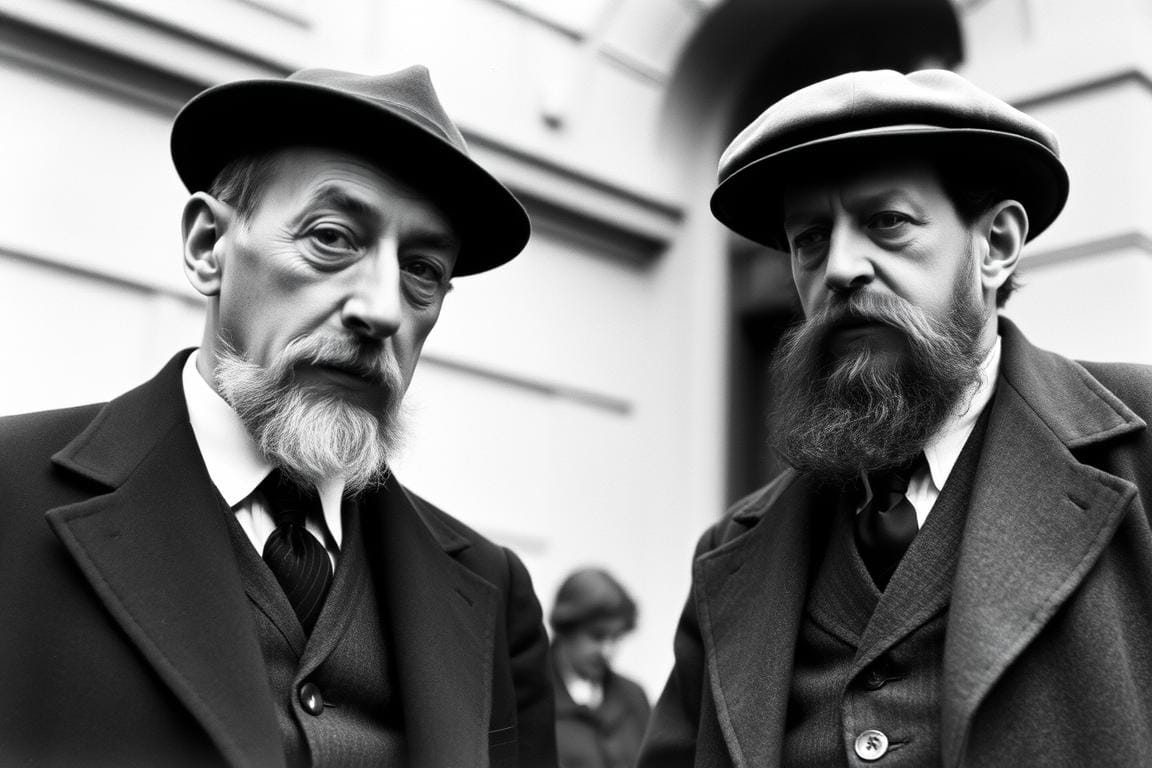
Personal Life and Relationships
Both profound connections and significant challenges marked Eliot’s personal life. In 1915, he married Vivienne Haigh-Wood after a brief courtship. Their marriage proved troubled, complicated by Vivienne’s physical and mental health issues and Eliot’s own reserved nature. The couple separated in 1932, and Vivienne was committed to a mental hospital in 1938, where she remained until her death in 1947.
From 1933 to 1946, Eliot maintained a close emotional relationship with Emily Hale, though this connection never culminated in marriage. Later in life, at the age of 68, Eliot married Esmé Valerie Fletcher, who was 30. Unlike his first marriage, this relationship brought Eliot happiness in his final years. After his death, Valerie dedicated herself to preserving his literary legacy.
Throughout his life, Eliot underwent significant spiritual transformations. In 1927, he converted from Unitarianism to Anglicanism and became a British citizen, formally renouncing his American citizenship. He described himself as “classicist in literature, royalist in politics, and anglo-catholic in religion,” reflecting the conservative values that increasingly defined his worldview.
Literary Career: Revolution in Verse
Early Works and Poetic Innovation
Eliot’s literary career began in earnest with the publication of “The Love Song of J. Alfred Prufrock” in Poetry magazine in 1915, thanks to Ezra Pound’s recommendation. This groundbreaking poem, with its now-famous opening lines comparing the evening sky to “a patient etherised upon a table,” immediately established Eliot as a revolutionary voice in modern poetry. The poem’s fragmented narrative, stream-of-consciousness technique, and profound psychological insight marked a decisive break from Victorian and Georgian poetic traditions.
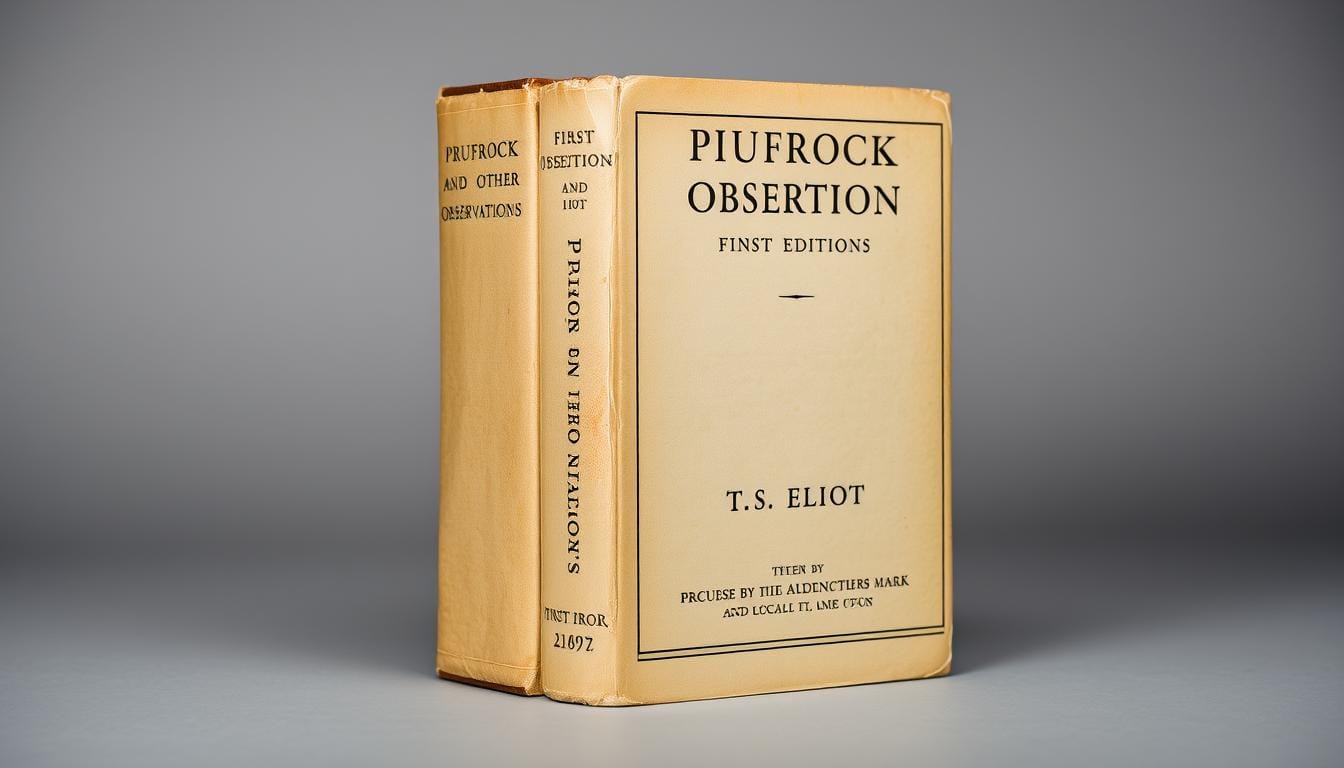
First edition of “Prufrock and Other Observations” (1917)
His first collection, “Prufrock and Other Observations,” published in 1917, further cemented his reputation as a leading poet of the avant-garde. During this period, Eliot was working at Lloyds Bank in London while simultaneously developing his literary voice. His poetry from this time reflects the alienation and disillusionment that characterized the post-World War I intellectual climate.
“April is the cruelest month, breeding
Lilacs out of the dead land, mixing
Memory and desire, stirring
Dull roots with spring rain.”
The Waste Land and Modernist Triumph T.S. Elliot
In 1922, Eliot published what would become his most famous work, “The Waste Land.” This complex, fragmented poem, with its multiple voices, languages, and literary allusions, is widely regarded as the single most influential poetic work of the twentieth century. Edited by Ezra Pound from a much longer manuscript, “The Waste Land” expresses the disenchantment and spiritual emptiness of European civilization in the aftermath of World War I.
The poem’s innovative structure, its juxtaposition of high and low cultural references, and its linguistic experimentation revolutionized poetic technique. Though Eliot later distanced himself from interpretations of the poem as expressing “the disillusion of a generation,” its impact on literary modernism was immediate and profound.
Dive Deeper into T.S. Eliot Masterpieces
Unlock the complexities of “The Waste Land” and other groundbreaking works with our comprehensive analysis guide. Perfect for students, teachers, and literature enthusiasts.
Middle Period: Spiritual Transformation
Following his conversion to Anglicanism in 1927, Eliot’s poetry underwent a distinctly spiritual shift. “Ash Wednesday” (1930), often referred to as his “conversion poem,” marked a significant change in both theme and style. The poem explores the struggle of religious faith and the journey toward spiritual redemption. Unlike his earlier works, which were characterized by irony and multiple voices, “Ash Wednesday” adopts a more meditative, lyrical approach.
During this period, Eliot also began writing for the theater. His first major dramatic work, “Murder in the Cathedral” (1935), based on the assassination of Archbishop Thomas Becket, explores themes of martyrdom and the conflict between spiritual and temporal power. This was followed by “The Family Reunion” (1939), which adapts Greek tragedy to modern themes of guilt and redemption.
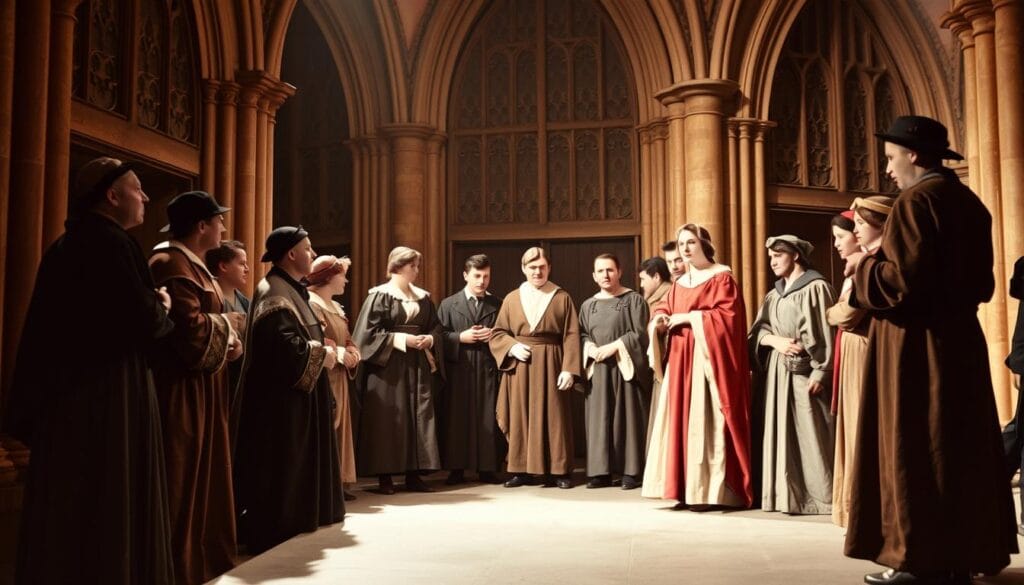
A performance of “Murder in the Cathedral” (1935)
Four Quartets and Later Works
Eliot considered “Four Quartets” (1943) his masterpiece, and many critics agree. This sequence of four long poems—”Burnt Norton,” “East Coker,” “The Dry Salvages,” and “Little Gidding”—explores time, history, spirituality, and the search for meaning. Written during World War II, these meditative poems reflect on the cyclical nature of human experience and the possibility of transcendence.
In his later years, Eliot focused increasingly on writing for the theater, producing plays such as “The Cocktail Party” (1949), “The Confidential Clerk” (1953), and “The Elder Statesman” (1958). These works, while less revolutionary than his poetry, continued to explore themes of spiritual redemption and human relationships within the context of modern society.
“We shall not cease from exploration
And the end of all our exploring
Will be to arrive where we started
And know the place for the first time.”
Literary Criticism and Editorial Work
Beyond his poetry and plays, Eliot made significant contributions as a literary critic and editor. His essays, collected in volumes such as “The Sacred Wood” (1920) and “Selected Essays” (1932), helped shape modern literary criticism. His concept of the “objective correlative” and his analysis of the “dissociation of sensibility” in metaphysical poetry continue to have a lasting influence on literary theory.
From 1925 until his death, Eliot worked as an editor at the publishing house Faber and Faber, where he championed the work of many younger poets, including W.H. Auden and Ted Hughes. His editorial decisions significantly contributed to shaping the canon of modern English poetry.
Cultural Impact: Reshaping Literary Landscapes
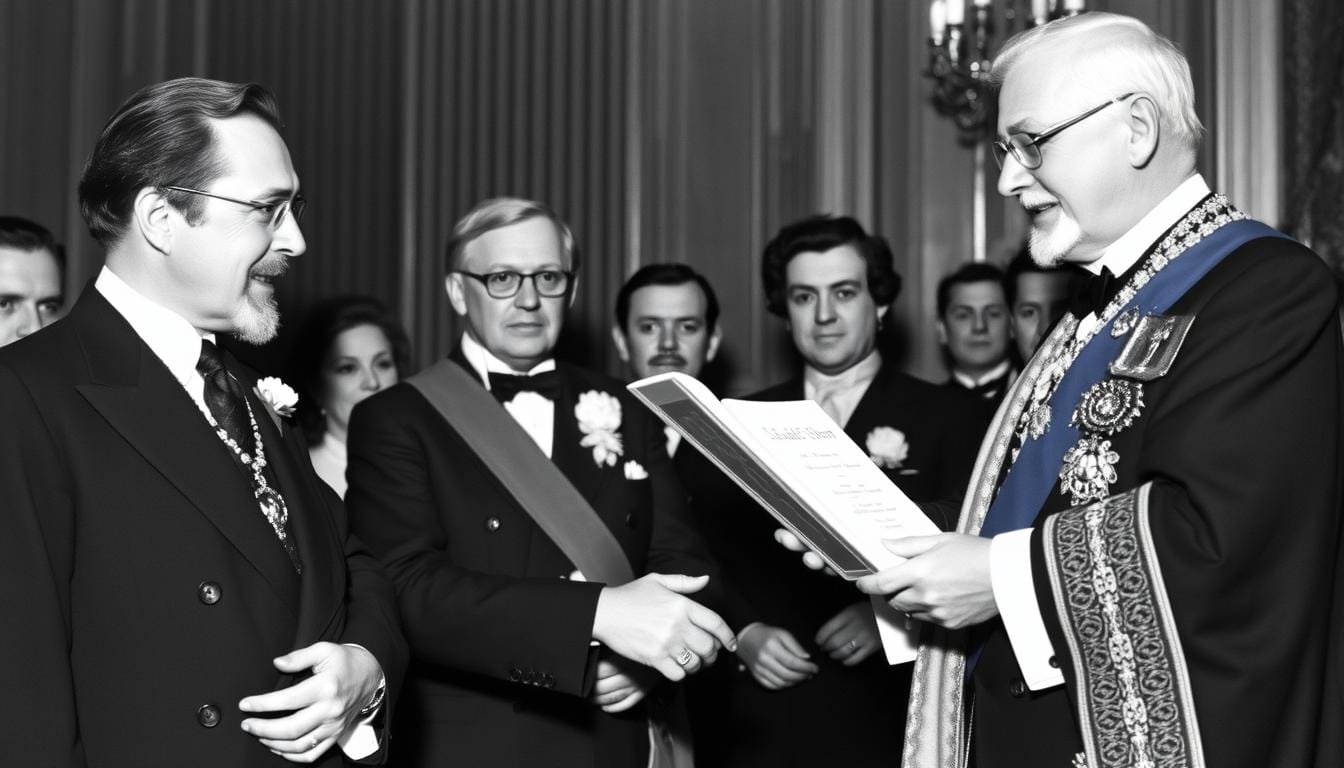
Influence on Modernist Poetry
T.S. Eliot’s impact on modernist poetry cannot be overstated. He revolutionized poetic language by breaking from traditional forms and introducing a new complexity that reflected the fragmented experience of modern life. His technical innovations—including the use of free verse, juxtaposition, literary allusion, and multiple voices—created a template for modernist expression that poets continue to draw from today.
Eliot’s influence extended beyond the English-speaking world. His work was translated into numerous languages, and poets from diverse cultural backgrounds found in his techniques new possibilities for their own expression. The Greek poet George Seferis, for instance, translated “The Waste Land” in 1936, while Caribbean poets like Derek Walcott acknowledged Eliot’s influence on their epic works.
Critical Reception During His Lifetime
The critical response to Eliot’s work evolved throughout his career. His early poems, particularly “The Love Song of J. Alfred Prufrock” and “The Waste Land,” were initially met with confusion and even hostility from some critics who found them obscure and disconnected. However, a cadre of influential critics, including Edmund Wilson and Conrad Aiken, recognized their revolutionary importance.
By the 1940s, following the publication of “Four Quartets,” Eliot’s reputation had reached its zenith. He was widely regarded as the preeminent poet of his age, a status confirmed by his receipt of the Nobel Prize for Literature in 1948. During what critic Cynthia Ozick called “the Age of Eliot,” his influence on literary culture was so pervasive that his aesthetic judgments and critical opinions shaped the entire literary landscape.
Major Literary Awards
- Nobel Prize in Literature (1948)
- Order of Merit (1948)
- Hanseatic Goethe Prize (1955)
- Dante Medal (1959)
- Tony Award for Best Play for “The Cocktail Party” (1950)
Key Critical Works
- “The Sacred Wood” (1920)
- “Tradition and the Individual Talent” (1919)
- “The Metaphysical Poets” (1921)
- “Notes Towards the Definition of Culture” (1948)
- “The Use of Poetry and the Use of Criticism” (1933)
Literary Legacy
Eliot’s legacy in literature remains complex and contested. While his technical innovations and critical insights continue to influence contemporary poetry, aspects of his work—particularly his political conservatism and instances of antisemitism in some early poems—have been subject to increasing scrutiny.
Nevertheless, his major poems, especially “The Waste Land” and “Four Quartets,” remain central to the canon of English-language poetry. His critical essays, particularly “Tradition and the Individual Talent,” continue to shape our understanding of the relationship between literary innovation and tradition.
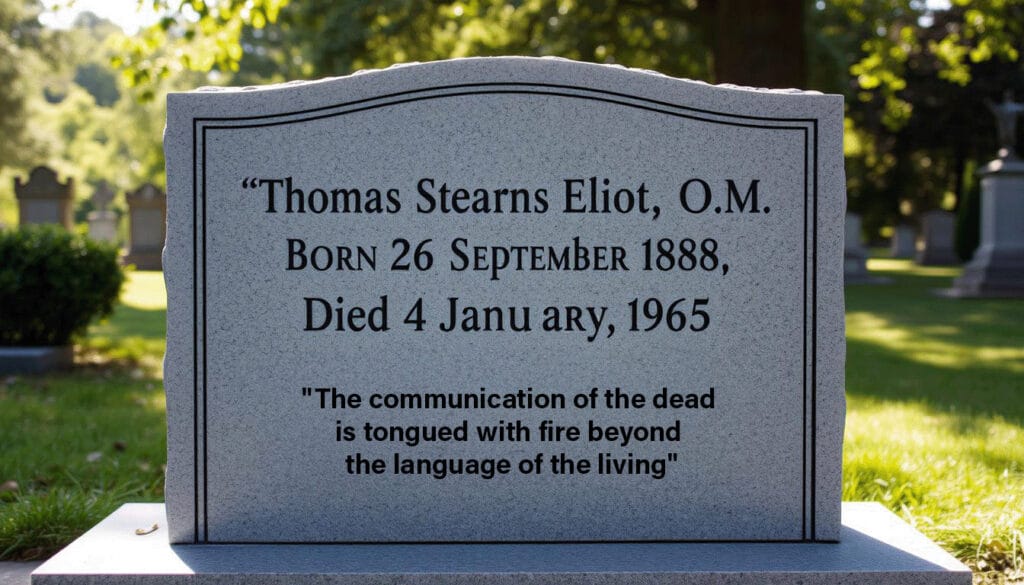
T.S. Elliot’s memorial stone in Poets’ Corner, Westminster Abbey
Eliot’s influence extends beyond literature into popular culture. His collection of whimsical verses, “Old Possum’s Book of Practical Cats” (1939), became the basis for Andrew Lloyd Webber’s long-running musical “Cats.” Lines from his poetry, such as “This is the way the world ends / Not with a bang but a whimper” from “The Hollow Men,” have entered common parlance, often quoted in contexts far removed from their original meaning.
Historical Context: Poetry in a Time of Crisis
World War I and Its Aftermath
T.S. Eliot’s formative years as a poet coincided with one of the most traumatic periods in modern history. World War I (1914-1918) shattered the optimistic worldview of the pre-war era, leaving in its wake a profound sense of disillusionment and cultural dislocation. Although Eliot did not serve in the war himself, the impact of the war on European society deeply influenced his work.
“The Waste Land,” published in 1922, can be read as a response to the spiritual and cultural devastation of the war. Its fragmented structure, multiple voices, and images of sterility and death reflect the broken world that emerged from the conflict. The poem’s famous opening line, “April is the cruelest month,” inverts traditional associations of spring with renewal, suggesting instead that rebirth is painful in a world so deeply scarred.
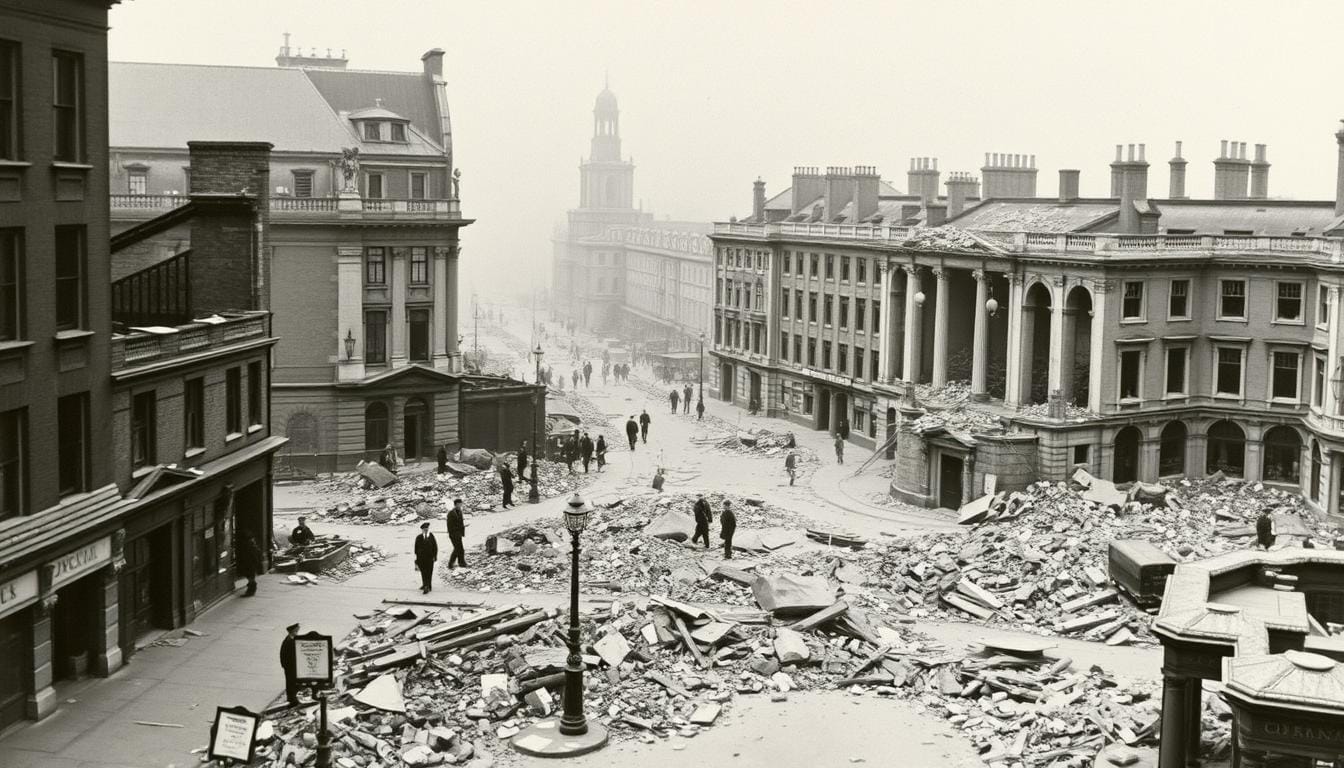
Post-war London, the setting that influenced “The Waste Land”
Modernism and Cultural Transformation
Eliot was a central figure in the modernist movement, which emerged in response to the rapid social, technological, and intellectual changes of the early 20th century. Modernism rejected Victorian certainties in favor of experimentation, complexity, and a new engagement with the unconscious mind, influenced by the theories of Sigmund Freud and others.
In his poetry and criticism, Eliot helped define the modernist aesthetic. His essay “Tradition and the Individual Talent” (1919) articulated a new understanding of literary history, arguing that innovation must be understood in relation to tradition. This dialectical approach to past and present became a cornerstone of modernist thinking.
“The historical sense compels a man to write not merely with his own generation in his bones, but with a feeling that the whole of the literature of Europe from Homer and within it the whole of the literature of his own country has a simultaneous existence and composes a simultaneous order.”
Religious and Philosophical Currents
Eliot’s work was deeply influenced by philosophical and religious currents of his time. His early poetry reflects the influence of French Symbolists, such as Jules Laforgue, and the philosophy of F.H. Bradley, whose work was the subject of Eliot’s doctoral dissertation. Following his conversion to Anglicanism in 1927, his work increasingly drew upon Christian theology and mystical traditions.
“Four Quartets,” written during World War II, draws on diverse spiritual sources, including the mysticism of St. John of the Cross and Julian of Norwich, as well as Eastern philosophical traditions that Eliot studied at Harvard. The poems explore the relationship between time and eternity, suggesting that moments of spiritual insight can transcend historical circumstance.
Explore T.S. Eliot’s World
Discover how historical events shaped Eliot’s revolutionary poetry with our interactive timeline. See the connections between world events and literary innovation.
The Changing Literary Landscape
Eliot’s career spanned a period of dramatic change in the literary world. When he began publishing, poetry was still bound mainly by Victorian and Georgian conventions. By the time of his death in 1965, literature had undergone multiple transformations, from modernism to various postmodern movements.
As an editor at Faber and Faber from 1925 onward, Eliot played a crucial role in shaping this evolving literary landscape. He published and championed younger poets whose work would define subsequent generations, including W.H. Auden, Stephen Spender, and, later, Ted Hughes. His influence as a cultural arbiter was as significant as his contributions as a poet.
Major Works: A Literary Revolution
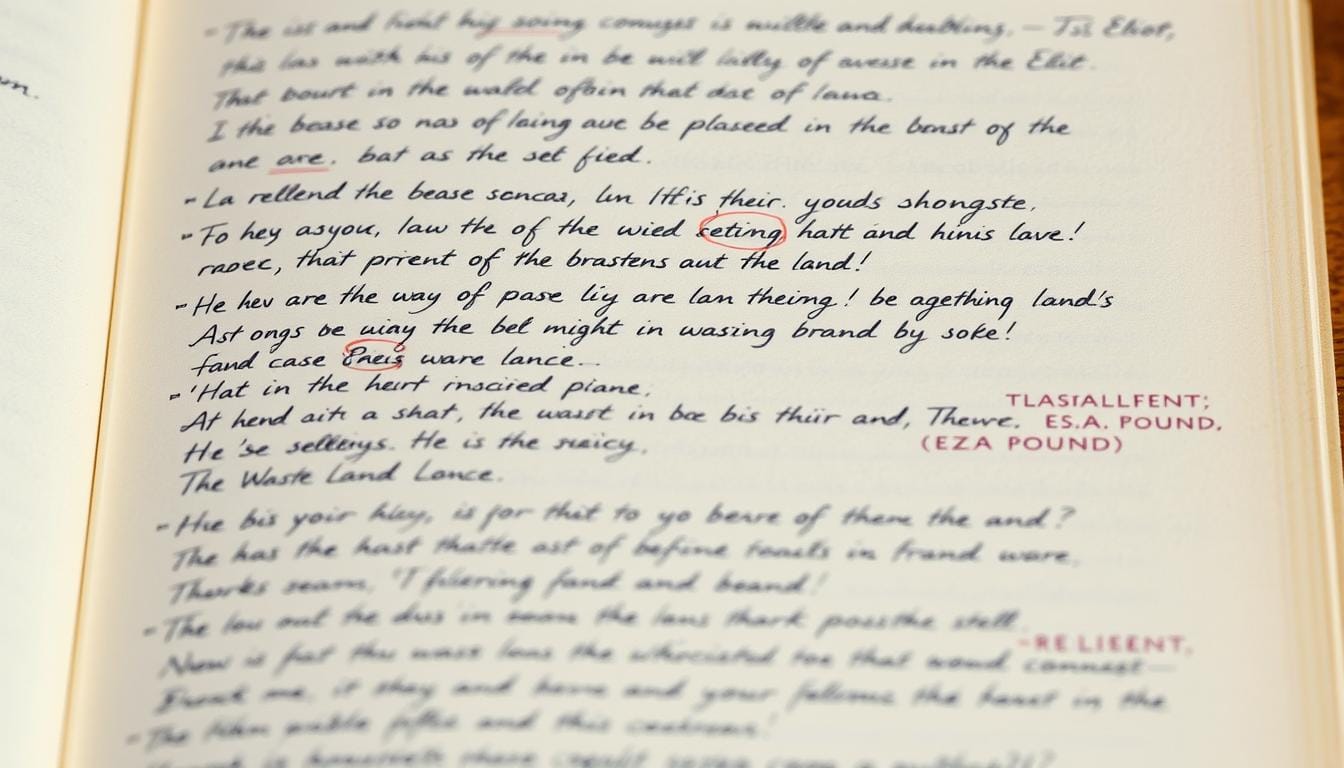
Original manuscript page of “The Waste Land” with Ezra Pound’s edits
T.S. Elliot Groundbreaking Poetry
T.S. Eliot’s poetic output was relatively small compared to many of his contemporaries, but each work represented a significant artistic achievement. His major poetic works chart the evolution of his style and concerns, from the alienation and irony of his early work to the spiritual meditation of his later poems.
“The Love Song of J. Alfred Prufrock” (1915)
Eliot’s first major published poem introduced his distinctive voice to the literary world. The poem presents the interior monologue of a hesitant, middle-aged man paralyzed by social anxiety and existential doubt. Its stream-of-consciousness technique and urban imagery established a new poetic language for the modern age.
“The Waste Land” (1922)
Often regarded as the defining poem of modernism, “The Waste Land” is a complex and fragmented work that draws on diverse cultural and literary sources. Through its five sections, the poem presents a vision of spiritual aridity in post-war European civilization, juxtaposing high cultural references with the vernacular of modern urban life.
“Four Quartets” (1943)
Comprising four long poems—”Burnt Norton,” “East Coker,” “The Dry Salvages,” and “Little Gidding”—this sequence represents Eliot’s mature meditation on time, history, and spirituality. Each quartet is associated with one of the four elements and explores the possibility of moments of transcendence within the flux of temporal existence.
T.S. Elliot Dramatic Works
After the publication of “The Waste Land,” Eliot increasingly turned his attention to writing for the theater. His plays combine poetic language with dramatic form, often exploring religious and ethical themes within contemporary settings.
Religious Drama
- “Murder in the Cathedral” (1935) – Based on the assassination of Archbishop Thomas Becket, this verse drama explores themes of martyrdom and the conflict between spiritual and temporal authority.
- “The Rock” (1934) – A pageant play commissioned for the benefit of London churches, featuring choruses that reflect on the role of the church in modern society.
Modern Comedies
- “The Cocktail Party” (1949) – A verse comedy that adapts the structure of Greek drama to explore themes of marital discord and spiritual healing in contemporary society. It won the Tony Award for Best Play.
- “The Confidential Clerk” (1953) and “The Elder Statesman” (1958) – Later plays that continue Eliot’s exploration of family relationships and personal redemption in modern settings.
T.S. Elliot Critical Essays
Eliot’s critical writings were as influential as his poetry in shaping modern literary sensibilities. His essays combined erudition with practical insight into the craft of poetry, establishing new frameworks for understanding literary tradition and innovation.
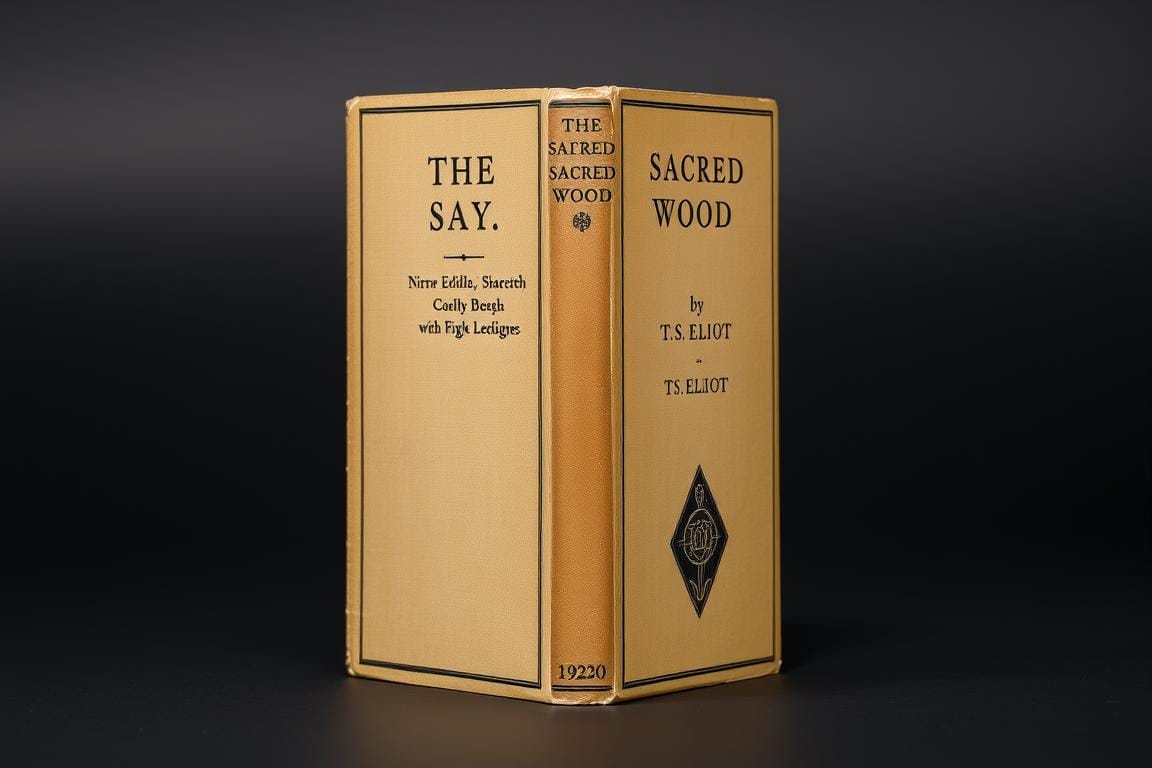
First edition of “The Sacred Wood” (1920)
Key critical works include “The Sacred Wood” (1920), which contains the seminal essay “Tradition and the Individual Talent”; “The Use of Poetry and the Use of Criticism” (1933), based on his Harvard lectures; and “Notes Towards the Definition of Culture” (1948), which explores the relationship between religion, culture, and education.
Through these works, Eliot introduced influential concepts such as the “objective correlative” and the “dissociation of sensibility,” while also reviving interest in previously neglected poets, particularly the Metaphysical poets of the 17th century.
Modern Relevance: T.S. Elliot in the Contemporary World
Academic and Literary Influence
Despite shifts in critical fashion, T.S. Eliot remains a central figure in literary studies. His major poems continue to be taught in universities worldwide, and scholarly work on his writing remains vibrant. The complete publication of his letters, along with the release of his correspondence with Emily Hale in 2020 (following a 50-year embargo), has sparked renewed interest in his life and work.
Contemporary poets continue to engage with Eliot’s legacy, whether through direct influence or in reaction against his aesthetic and political positions. His technical innovations—particularly his use of fragmentation, juxtaposition, and allusion—have become fundamental tools in the poet’s craft.

Contemporary performance of “Cats,” based on Eliot’s “Old Possum’s Book of Practical Cats”
T.S. Elliot Popular Culture Adaptations
Eliot’s work has found surprising resonance in popular culture. Most famously, his collection “Old Possum’s Book of Practical Cats” formed the basis for Andrew Lloyd Webber’s musical “Cats,” which became one of the longest-running shows in Broadway history. This adaptation introduced Eliot’s whimsical verses to audiences who might never have encountered his more serious poetry.
Beyond “Cats,” Eliot’s influence can be traced in film, music, and other media. His phrases have become part of common usage, and references to his work appear in contexts ranging from academic discourse to popular entertainment. Films like “Apocalypse Now” draw on “The Hollow Men,” while musicians as diverse as Bob Dylan and The Cure have acknowledged Eliot’s influence on their lyrics.
Relevance to Contemporary Issues
Many of the themes Eliot explored—spiritual emptiness in materialist society, the fragmentation of modern experience, the search for meaning in a secular age—remain acutely relevant today. His poetry resonates with the alienation and disorientation that many people experience in our rapidly changing, technologically mediated world.
At the same time, contemporary readers engage critically with aspects of Eliot’s worldview, particularly his political conservatism and instances of antisemitism in some early poems. This critical engagement reflects how literary works continue to evolve in meaning as they are read in new historical contexts.
“This is the way the world ends
Not with a bang but a whimper.”
These famous lines from “The Hollow Men” continue to resonate in discussions of environmental crises, nuclear threats, and social decline, demonstrating how Eliot’s poetic vision remains a powerful language for contemporary concerns.
The Life and Times of T.S. Elliot Conclusion: The Enduring Voice
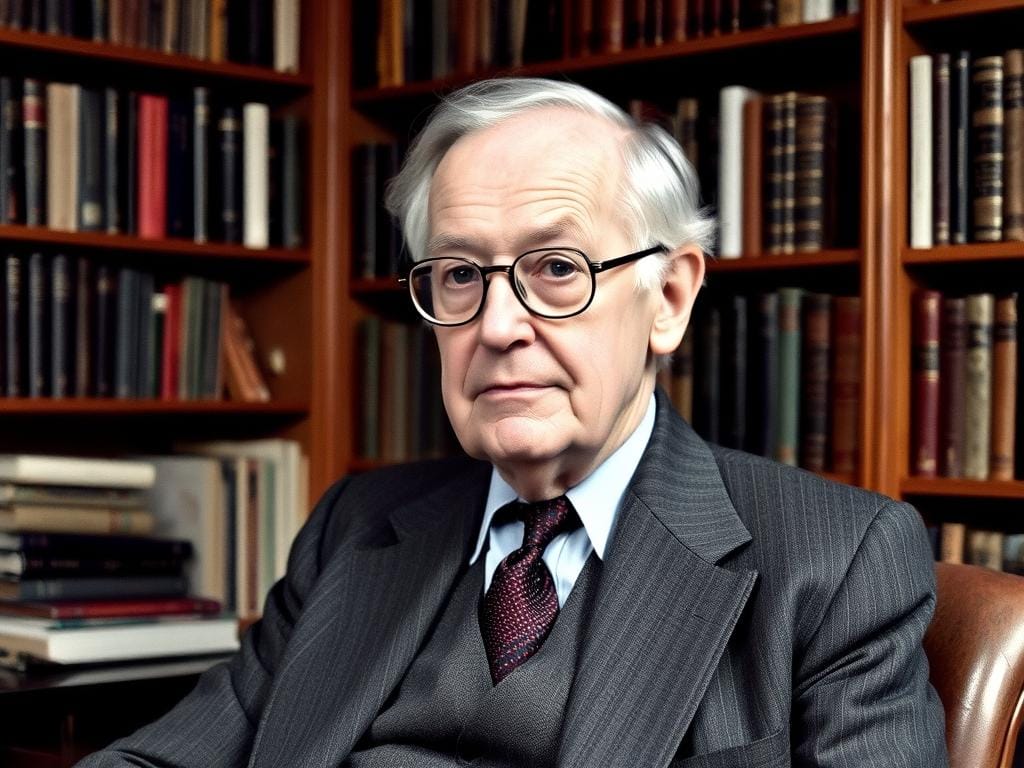
The Life and Times of T.S. Elliot: T.S. Elliot in his later years
T.S. Eliot’s journey from a privileged youth in St. Louis to becoming one of the most influential literary figures of the 20th century reflects the transformative power of artistic vision. Through his revolutionary approach to poetic language, his penetrating critical insights, and his exploration of the human condition in an age of spiritual crisis, Eliot created a body of work that continues to challenge and inspire readers.
His technical innovations—the fragmented narrative, the juxtaposition of high and low cultural references, the use of multiple languages and voices—created new possibilities for poetic expression that subsequent generations of writers have built upon. His critical writings reshaped our understanding of literary tradition and the relationship between past and present in artistic creation.
Beyond his technical achievements, Eliot’s work continues to resonate with fundamental human concerns: the search for meaning in a world of flux, the possibility of spiritual insight in a secular age, and the challenge of forming authentic connections in modern society. As we navigate our own era of rapid change and cultural transformation, Eliot’s voice remains a guide to the complexities of modern experience and the enduring power of artistic vision.
T.S. Elliot In the words of his own “Little Gidding,” we may find that our exploration of Eliot’s work leads us “to arrive where we started / And know the place for the first time”—seeing our own world with fresh insight through the lens of his remarkable poetic imagination.







